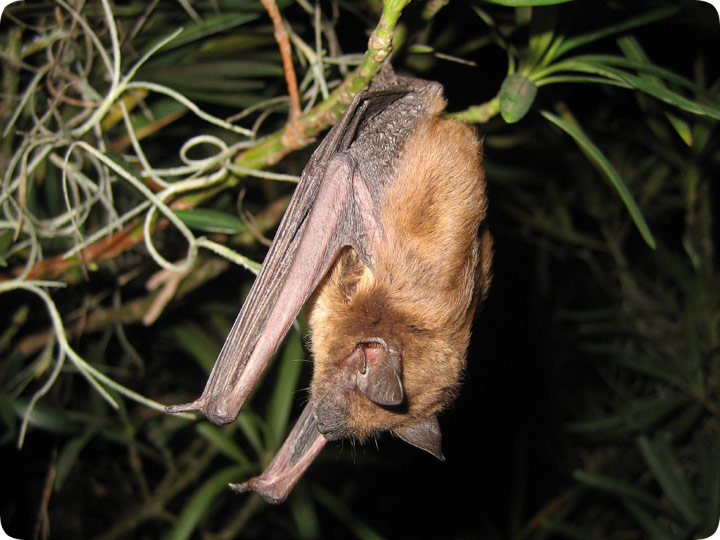-
info@aaanimalcontrol.com
Call us for help in your town
Humane Wildlife Education
A Male Bat Hanging in a Tree

Male bats live a solitary life, roosting in any convenient place that suits them. On occasion, I get a call from someone who has found a solitary bat roosting for the day. Interestingly, they seem to like the folds of a large patio umbrella. Then when the homeowner opens the umbrella, they get a surprise that drives them just plain batty. Then they call me, and I say, "just leave it alone, for Pete's sake, it's not going to hurt anyone!" I also think they like to go behind shutters, because I've found them behind shutters. So there you have it, my research indicates that male bats make their daytime roost in trees, folded up umbrellas, and shutters.
The above photo features a male bat in a tree. Granted, I took it during the night time, when it should be out flying, and granted, it's hanging about when most roosting bats are squished as deep as they can get inside a crevice, but I was most certainly able to identify it as a male, and I don't deal with male bats very often. Like mosquitoes, the fellows aren't the ones causing the problems. True true, it's all because of the responsibility of the female to take care of the minor detail of giving birth, but still, one can't ignore the fact that females are a pain in the butt in general. I see these maternity colonies of bats in homes, and it's like one big girl's slumber party, the bats doing the things most ladies do - chattering away, grooming themselves, bickering, pooping all over the place indiscriminately, and so on. The guys as usual are shunned, forced to hang around in some batchelor, I mean bachelor, pad all day.
Do it yourself: Visit my How To Get Rid of Bats page for tips and advice.
Get professional help: Visit my Nationwide Pro Directory of wildlife removal experts.
For more wildlife stories, click my Wildlife Blog or click my below banner to hire a local trapper.

Bats are very fascinating creatures. They’ve been around since the age of dinosaurs and are the only mammals with the ability to fly. Contrary to popular opinion, they’re not blind but they make use of a sophisticated system of echolocation to locate their prey. There are over 1,000 species of bats in the world but only about 40 are present in North America.
One interesting feature of bats is their mating behavior and the disparate lifestyle between males and females. The purpose of this post is to contrast how male bats differ from females in their lifestyles.
Sexual Behavior
Male and female bats tend to remain separate in summer until mating commences in early fall in a process known as delayed fertilization. Here, the female stores up sperm in her reproductive organ until the next spring when ovulation occurs and embryonic development begins. Most species of bat give birth to only one pup a year and nurse for about 6 weeks.
Bat Maternity Colony
Once mating is over, pregnant females from a new maternity colony of about 40 pregnant bats, who will desert their initial colonies. However, some species form very large colonies. The largest maternity colony in the world is in Bracken Cave and it contains approximately 15 million bats. They then roost within colonies in safe, warm, and dark places, like caves, abandoned buildings, abandoned mine shafts, or attics. After giving birth to their pups, the colony size doubles.
Colonies are formed because there is safety in numbers. Also, they support each other during pregnancy and taking care of the babies. Although the mother constantly stays with her pup, after some time, the babies grow stronger and can fend for themselves.
Bat colonies form a crucial role in the ecosystem. That’s why they’re protected by the law. Aside from helping to keep the insect population in check, they also aid in pollination.
If you have a bat colony in your attic, you’re likely dealing with female bats.
The Life of a Solitary Male Bat
Male bats, on the other hand, live a solitary life, roosting in any convenient spot. During the daytime, they typically roost in trees but you might find them in funny places like behind shutters or under a large patio umbrella. In the wild, males tend to roost in high altitudes.
During the mating season, males look for suitable females. Females are relatively easy to find because they live in colonies. Thereafter, they mate all day with multiple partners. Once mating is done, they return to their solitary life, hanging upside down in a tree, or building. They are not involved in pup-rearing and will only interact with females during the next mating season.
Conclusion
In general, female bats live in colonies, while males tend to live solitary lives. They typically only interact during the mating season.




















